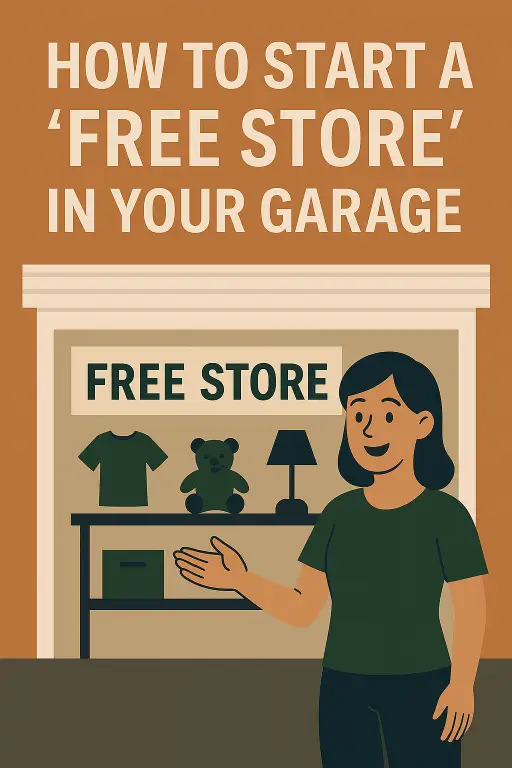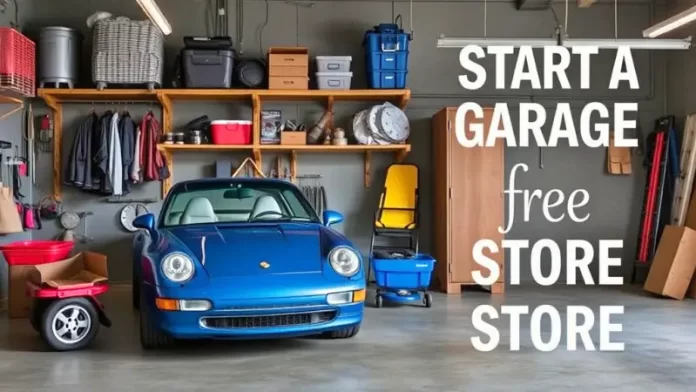Imagine walking into a shop where every single item on the shelves is absolutely free. No catch, no strings attached. Sounds like a utopian dream, right? Or maybe just a really good daydream during a cost-of-living squeeze. But what if I told you this concept, the ‘Free Store’, is not only real but is popping up in the most wonderfully ordinary of places like your neighbor’s garage, or maybe even your garage?
Here inthis year, with folks increasingly looking for ways to build stronger communities, live more sustainably, and push back against the relentless “buy, buy, buy” culture, the idea of a garage free store is gaining some serious traction. It’s a hyperlocal, super practical way to make a tangible difference. So, got a garage that’s doing little more than collecting dust and long-forgotten sports equipment? Or perhaps you just have a burning desire to foster a bit more generosity in your neighborhood? Let’s explore how to start a ‘Free Store’ in your garage, and the powerful reasons why you might just want to.
Table of Contents
The “Why”: More Than Just Free Stuff – The Beautiful Benefits
Before we dive into the nuts and bolts, let’s talk about the heart of it. Why would anyone dedicate their garage space and a bit of their time to giving things away for free? The reasons are as inspiring as they are practical.
- Championing Sustainability & Slashing Waste: This is a HUGE one. A garage free store directly tackles our throwaway culture. Perfectly good items clothes, books, kitchen gadgets, toys get a new lease on life instead of ending up in a landfill. It’s the ultimate embodiment of reduce, reuse, recycle (and let’s not forget repair!). Every item reused is one less new item that needs to be manufactured, saving resources and energy.
- A Gentle Nudge Against Hyper-Consumerism: Free stores offer a tangible alternative to constantly buying new. They encourage a mindset of sufficiency appreciating and using what already exists in the community. It’s a quiet rebellion against the idea that happiness is just one Amazon purchase away.
- Weaving a Stronger Community Fabric: Oh, this is where the magic really happens. A free store becomes a natural meeting point. Neighbors connect, chat, share stories, and build relationships. Such spaces becomes vibrant little hubs of goodwill, fostering trust and a genuine sense of belonging. In an increasingly disconnected world, that’s priceless.
- Real-Deal Mutual Aid & Support: For folks facing financial hardship, a free store can be a lifeline, providing access to essential items without the stigma sometimes associated with traditional charity. It’s about neighbors helping neighbors, fostering dignity and direct support. The impact here can be profound.
- Decluttering with a Conscience: Let’s be honest, many of us have too much stuff. A free store provides a meaningful destination for those items you no longer need but someone else could cherish. It feels a whole lot better than just chucking it or letting it gather dust.
- An Accidental Classroom for All Ages: Kids (and adults!) learn valuable lessons about sharing, resourcefulness, generosity, and the environmental impact of their choices. It’s a hands-on education in community values and sustainable living.
- Empowerment Through Action: Feeling overwhelmed by global problems? Starting something hyperlocal like a garage sharing hub is an incredibly empowering way to take direct, positive action. You can make a difference, right where you are. It’s a win-win-win situation, really.

The “How-To”: Your Blueprint for a Buzzing Garage Free Store
Convinced (or at least curious)? Fantastic! Starting a free store garage doesn’t require a massive budget or a committee of experts. Here’s a step-by-step guide to get you rolling:
Step 1: Dot Your I’s & Cross Your T’s (The Quick Legal Check)
Before you get too excited, take a moment for the less thrilling but important stuff.
- Local Regulations: In most places, a small, informal, non-commercial sharing initiative in your garage won’t raise eyebrows. But a quick check on your local municipality’s website regarding home-based activities or zoning can’t hurt, especially if you plan for it to be a very active spot.
- Homeowner Association (HOA) Rules: If you’re part of an HOA, peek at your community guidelines. Some have rules about what you can operate from your home, even if it’s non-profit. Ignoring this could led to problems down the road.
Step 2: Define Your Vision – Scope & “House Rules”
A little planning goes a long way.
- What’s In, What’s Out? Decide what types of items you’ll accept and offer. Common exclusions: broken or dirty items, hazardous materials, large unmanageable appliances (unless you have space and help!), expired food, or weapons. Be clear.
- Hours of Operation: Will it be open 24/7 via an accessible shelf at the end of your driveway? Or specific hours when you can supervise (e.g., Saturday mornings)? Consider what’s sustainable for you.
- The Guiding Philosophy: Most free stores operate on a “take what you need, leave what you can (if you can)” basis. Trust is usually the operating principle. Explicitly stating “Everything is Free!” is key. Limits per person are generally discouraged as they can create barriers.
Step 3: Prep Your Space – Make it Welcoming!
Transform that garage (or a section of it) into an inviting little shop.
- Clean & Declutter: A good sweep and tidy-up makes a world of difference.
- Organize for Ease: Use shelves, tables, sturdy boxes, or plastic bins to sort items. Label sections if it helps (e.g., “Kids’ Clothes,” “Books,” “Kitchenware”). This make Browse much more pleasant.
- Clear Signage: A big, friendly “FREE STORE” sign is essential. Also, post your “house rules” (e.g., “Please only leave clean, usable items,” “Take what you need”). Maybe a little note about why you’ve started it.
Step 4: The Initial “Stock” – Priming the Pump
You need some items to get started!
- Your Own Declutter: This is the perfect catalyst. Go through your own home for quality items you no longer need.
- Friendly Foundations: Ask supportive friends, family, and immediate neighbors if they have any good-condition items they’d like to contribute to kick things off.
Step 5: Spread the Word (Gently Does It at First)
You don’t need a massive marketing campaign.
- Start Local: Tell your immediate neighbors. Post on a hyper-local social media group (neighborhood Facebook page, WhatsApp group for your street/apartment complex). Pin a notice on a community bulletin board.
- Set the Tone: Emphasize that it’s a community sharing initiative, not a dumping ground for broken junk. Quality and respect are key.
Step 6: Lights, Camera, Action! (Well, Shelves, Items, Generosity!)
Organize the initial donations nicely. If you’ve set specific hours, be there for the “opening” to greet people, explain the concept, and build some early enthusiasm. If it’s a more passive setup, just make sure it’s clearly marked and accessible.
Step 7: The Ongoing TLC – Keeping the Good Vibes Flowing
A free store isn’t a “set it and forget it” project. Regular maintenance is crucial.
- Tidy & Reorganize: Dedicate a little time each week (or more often if it’s busy) to keep the space neat and items sorted. This is probably the most important task. Consistency in management are vital for success.
- Sort New Donations: Check new arrivals. Remove anything unsuitable (broken, dirty) and dispose of it responsibly (recycle, trash don’t just let it pile up).
- Communicate: Let your network know if you’re running low on specific types of items or if you have a surplus of something.
- Nip Problems in the Bud: Occasionally, someone might misunderstand and leave inappropriate items. Address this gently and clearly, perhaps with better signage.
Step 8: Rally the Troops! (Building Community & Volunteer Power)
As your free store gains traction, you might find others eager to help.
- Encourage Participation: Regular “customers” or supportive neighbors might be happy to help with tidying or sorting if you ask.
- Shared Ownership: The more the community feels involved, the more successful and sustainable your free store will be. It could even evolve into a more formally organized community sharing project.
Food for Thought: Important Considerations & Best Practices
A few more things to keep in your back pocket:
- Safety First: Ensure your garage is a safe space no tripping hazards, items stacked securely. If it’s an open-access area, consider visibility from your house.
- Accessibility Matters: Can people with strollers or mobility aids easily access the items? Maybe a few things on a lower, easily reached shelf?
- Managing the Flow of Donations: This can be tricky. Have a clear policy. If you get overwhelmed, it’s okay to temporarily pause accepting donations. A small sign explaining this are usually understood.
- Setting Personal Boundaries: This is your garage and your time. Don’t let it become a source of stress. It’s okay to have limited hours or to take breaks. Don’t bite off more than you can chew.
- Dignity & Respect Above All: The aim is to create a welcoming, judgment-free space where everyone feels comfortable giving and receiving.
- Patience is a Virtue: It takes time for word to spread and for the free store to become an established part of the neighborhood.
Beyond Your Garage: The Sky’s the Limit!
While this guide focuses on a garage setup, the “free store” concept is wonderfully adaptable. Think:
- A “Free Little Library” expanded to include small household items or non-perishable food.
- A designated shelf or room in a community center or place of worship.
- Pop-up “freecycling” events in a local park.
A small garage free shop can be a powerful seed, inspiring bigger and broader community sharing initiatives.
Ready to Open Your “Doors”?
Starting a free store in your garage is more than just an organizational project; it’s a labor of love and a bold statement about the kind of community you want to live in. It’s a tangible way to combat waste, foster connection, support neighbors, and challenge the status quo of endless consumption. It won’t solve all the world’s problems, of course, but it’s a powerful, positive, and deeply rewarding step in the right direction.
It doesn’t require a massive investment, just a bit of space, a willingness to organize, and a belief in the power of sharing. So, what do you say? Could your garage become the next little beacon of generosity and sustainability in your neighborhood? The impact of such initiatives often exceed initial expectations. Give it some thought!

